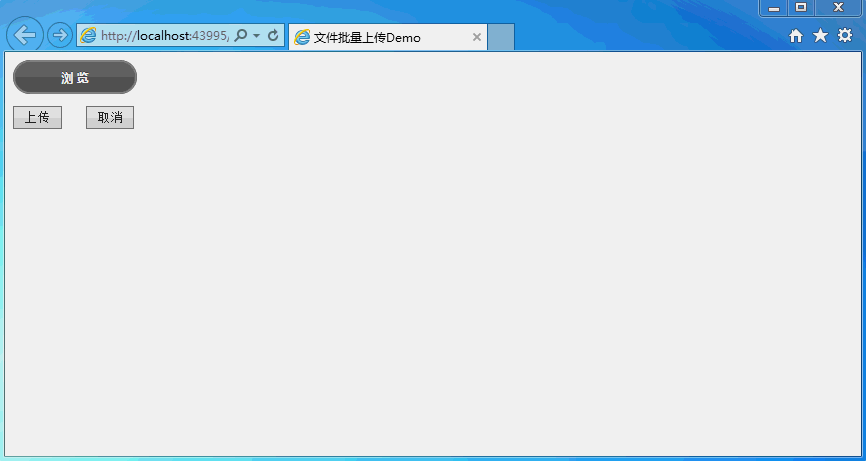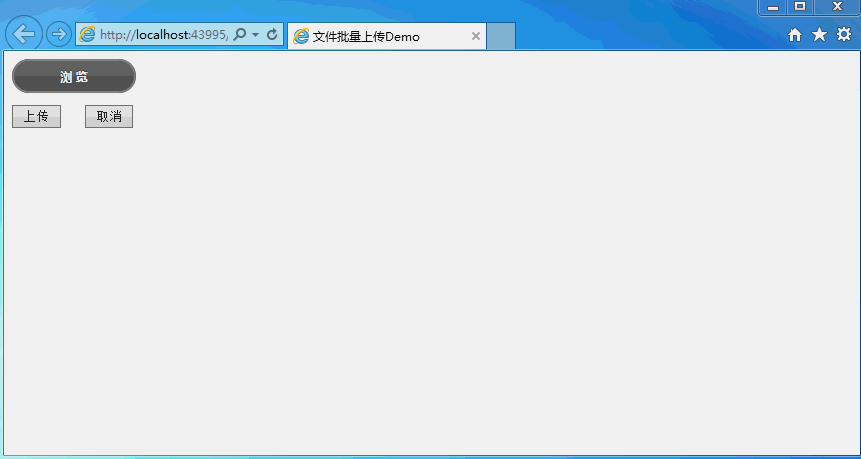Detaillierte Erläuterung der Verwendung des JQuery-Plug-Ins uploadify
Dieses Mal erkläre ich Ihnen ausführlich die Verwendung des JQuery-Plug-Ins Uploadify. Was sind die Vorsichtsmaßnahmen bei der Verwendung des JQuery-Plug-Ins Uploadify? .
Manchmal, wenn ein Projekt eine Datei-Batch-Upload-Funktion erfordert, denke ich persönlich, dass Uploadify eine schnelle und einfache Lösung ist. Die Details sind wie folgt:
Zuerst die Darstellungen:


Der spezifische Code lautet wie folgt:
lautet wie folgt auf der Seite

Vollständiger Seitencode
<%@ Page Language="C#" AutoEventWireup="true" CodeFile="Default.aspx.cs" Inherits="_Default" %>
<!DOCTYPE html>
<html xmlns="http://www.w3.org/1999/xhtml">
<head runat="server">
<meta http-equiv="Content-Type" content="text/html; charset=utf-8"/>
<title>文件批量上传Demo</title>
<!--引入Jquery-->
<script src="js/jquery-1.11.3.min.js"></script>
<!--引入uploadify-->
<script type="text/javascript" src="uploadify/jquery.uploadify.js"></script>
<link type="text/css" href="uploadify/uploadify.css" rel="stylesheet" />
<script type="text/javascript">
$(function () {
var guid = '<%=Request["guid"] %>';
var type = '<%=Request["type"] %>';
if (guid == null || guid == "") {
guid = newGuid();
}
if (type != null) {
type = type + '/';
}
$('#file_upload').uploadify({
'swf': 'uploadify/uploadify.swf', //FLash文件路径
'buttonText': '浏 览', //按钮文本
'uploader': 'uploadhandler.ashx?guid=' + guid, //处理ASHX页面
'formData': { 'folder': 'picture', 'isCover': 1 }, //传参数
'queueID': 'fileQueue', //队列的ID
'queueSizeLimit': 10, //队列最多可上传文件数量,默认为999
'auto': false, //选择文件后是否自动上传,默认为true
'multi': true, //是否为多选,默认为true
'removeCompleted': true, //是否完成后移除序列,默认为true
'fileSizeLimit': '0', //单个文件大小,0为无限制,可接受KB,MB,GB等单位的字符串值
'fileTypeDesc': 'All Files', //文件描述
'fileTypeExts': '*.*', //上传的文件后缀过滤器
'onQueueComplete': function (queueData) { //所有队列完成后事件
alert("上传完毕!");
},
'onError': function (event, queueId, fileObj, errorObj) {
alert(errorObj.type + ":" + errorObj.info);
},
'onUploadStart': function (file) {
},
'onUploadSuccess': function (file, data, response) { //一个文件上传成功后的响应事件处理
//var data = $.parseJSON(data);//如果data是json格式
//var errMsg = "";
}
});
});
function newGuid() {
var guid = "";
for (var i = 1; i <= 32; i++) {
var n = Math.floor(Math.random() * 16.0).toString(16);
guid += n;
if ((i == 8) || (i == 12) || (i == 16) || (i == 20))
guid += "-";
}
return guid;
}
//执行上传
function doUpload() {
$('#file_upload').uploadify('upload', '*');
}
</script>
</head>
<body>
<form id="form1" runat="server" enctype="multipart/form-data">
<p id="fileQueue" class="fileQueue"></p>
<p>
<input type="file" name="file_upload" id="file_upload" />
<p>
<input type="button" class="shortbutton" id="btnUpload" onclick="doUpload()" value="上传" />
<input type="button" class="shortbutton" id="btnCancelUpload" onclick="$('#file_upload').uploadify('cancel')" value="取消" />
</p>
<p id="p_show_files"></p>
</p>
</form>
</body>
</html>UploadHandler.ashx-Code:
using System;
using System.Web;
using System.IO;
public class UploadHandler : IHttpHandler {
public void ProcessRequest (HttpContext context) {
context.Response.ContentType = "text/plain";
context.Request.ContentEncoding = System.Text.Encoding.GetEncoding("UTF-8");
context.Response.ContentEncoding = System.Text.Encoding.GetEncoding("UTF-8");
context.Response.Charset = "UTF-8";
if (context.Request.Files.Count > 0)
{
#region 获取上传路径
string uploadFolder = GetUploadFolder();
#endregion
if (System.IO.Directory.Exists(uploadFolder))
{//如果上传路径存在
HttpPostedFile file = context.Request.Files["Filedata"];
string filePath = Path.Combine(uploadFolder, file.FileName);
file.SaveAs(filePath);
context.Response.Write("0");
}
else
{
context.Response.Write("2");
}
}
}
public bool IsReusable {
get {
return false;
}
}
/// <summary>
/// 返回不带后缀的文件名
/// </summary>
/// <param name="fileName"></param>
/// <returns></returns>
public static string GetFirstFileName(string fileName)
{
return Path.GetFileNameWithoutExtension(fileName);
}
/// <summary>
/// 获取上传目录
/// </summary>
/// <returns></returns>
public static string GetUploadFolder()
{
string rootPath = HttpContext.Current.Server.MapPath("~");
return Path.Combine(rootPath, "test");
}
}Datei-Upload hat eine Größenbeschränkung von Standardmäßig, wie die durch IIS begrenzte Standardanforderungsgröße von 30 MB. Wenn Sie IIS nicht ändern, aber diese Größenbeschränkung beispielsweise durchbrechen möchten, laden Sie eine 1-GB-Datei hoch.
Dies kann durch Ändern von Web.config erreicht werden.
<?xml version="1.0" encoding="utf-8"?> <!-- --> <configuration> <system.web> <compilation debug="true" targetFramework="4.0" /> <httpRuntime maxRequestLength="1073741824"/> </system.web> <!--用于设置文件上传的最大允许大小(单位:bytes)--> <system.webServer> <security> <requestFiltering> <!--修改服务器允许最大长度(1GB)--> <requestLimits maxAllowedContentLength="1073741824"/> </requestFiltering> </security> </system.webServer> </configuration>
Ich glaube, dass Sie die Methode beherrschen, nachdem Sie den Fall in diesem Artikel gelesen haben. Weitere spannende Informationen finden Sie in anderen verwandten Artikeln auf der chinesischen PHP-Website.
Empfohlene Lektüre:
Detaillierte Erläuterung der Verwendung von jQuery-Grundwissenspunkten
Das obige ist der detaillierte Inhalt vonDetaillierte Erläuterung der Verwendung des JQuery-Plug-Ins uploadify. Für weitere Informationen folgen Sie bitte anderen verwandten Artikeln auf der PHP chinesischen Website!

Heiße KI -Werkzeuge

Undresser.AI Undress
KI-gestützte App zum Erstellen realistischer Aktfotos

AI Clothes Remover
Online-KI-Tool zum Entfernen von Kleidung aus Fotos.

Undress AI Tool
Ausziehbilder kostenlos

Clothoff.io
KI-Kleiderentferner

AI Hentai Generator
Erstellen Sie kostenlos Ai Hentai.

Heißer Artikel

Heiße Werkzeuge

Notepad++7.3.1
Einfach zu bedienender und kostenloser Code-Editor

SublimeText3 chinesische Version
Chinesische Version, sehr einfach zu bedienen

Senden Sie Studio 13.0.1
Leistungsstarke integrierte PHP-Entwicklungsumgebung

Dreamweaver CS6
Visuelle Webentwicklungstools

SublimeText3 Mac-Version
Codebearbeitungssoftware auf Gottesniveau (SublimeText3)

Heiße Themen
 1385
1385
 52
52
 Ausführliche Erklärung zur Erlangung von Administratorrechten in Win11
Mar 08, 2024 pm 03:06 PM
Ausführliche Erklärung zur Erlangung von Administratorrechten in Win11
Mar 08, 2024 pm 03:06 PM
Das Windows-Betriebssystem ist eines der beliebtesten Betriebssysteme der Welt und seine neue Version Win11 hat viel Aufmerksamkeit erregt. Im Win11-System ist die Erlangung von Administratorrechten ein wichtiger Vorgang. Mit Administratorrechten können Benutzer weitere Vorgänge und Einstellungen auf dem System durchführen. In diesem Artikel wird ausführlich beschrieben, wie Sie Administratorrechte im Win11-System erhalten und wie Sie Berechtigungen effektiv verwalten. Im Win11-System werden Administratorrechte in zwei Typen unterteilt: lokaler Administrator und Domänenadministrator. Ein lokaler Administrator verfügt über vollständige Administratorrechte für den lokalen Computer
 Detaillierte Erläuterung der Divisionsoperation in Oracle SQL
Mar 10, 2024 am 09:51 AM
Detaillierte Erläuterung der Divisionsoperation in Oracle SQL
Mar 10, 2024 am 09:51 AM
Detaillierte Erläuterung der Divisionsoperation in OracleSQL In OracleSQL ist die Divisionsoperation eine häufige und wichtige mathematische Operation, die zur Berechnung des Ergebnisses der Division zweier Zahlen verwendet wird. Division wird häufig in Datenbankabfragen verwendet. Daher ist das Verständnis der Divisionsoperation und ihrer Verwendung in OracleSQL eine der wesentlichen Fähigkeiten für Datenbankentwickler. In diesem Artikel werden die relevanten Kenntnisse über Divisionsoperationen in OracleSQL ausführlich erörtert und spezifische Codebeispiele als Referenz für die Leser bereitgestellt. 1. Divisionsoperation in OracleSQL
 Wie verwende ich die PUT-Anfragemethode in jQuery?
Feb 28, 2024 pm 03:12 PM
Wie verwende ich die PUT-Anfragemethode in jQuery?
Feb 28, 2024 pm 03:12 PM
Wie verwende ich die PUT-Anfragemethode in jQuery? In jQuery ähnelt die Methode zum Senden einer PUT-Anfrage dem Senden anderer Arten von Anfragen, Sie müssen jedoch auf einige Details und Parametereinstellungen achten. PUT-Anfragen werden normalerweise zum Aktualisieren von Ressourcen verwendet, beispielsweise zum Aktualisieren von Daten in einer Datenbank oder zum Aktualisieren von Dateien auf dem Server. Das Folgende ist ein spezifisches Codebeispiel, das die PUT-Anforderungsmethode in jQuery verwendet. Stellen Sie zunächst sicher, dass Sie die jQuery-Bibliotheksdatei einschließen. Anschließend können Sie eine PUT-Anfrage senden über: $.ajax({u
 Detaillierte Erläuterung der Rolle und Verwendung des PHP-Modulo-Operators
Mar 19, 2024 pm 04:33 PM
Detaillierte Erläuterung der Rolle und Verwendung des PHP-Modulo-Operators
Mar 19, 2024 pm 04:33 PM
Der Modulo-Operator (%) in PHP wird verwendet, um den Rest der Division zweier Zahlen zu ermitteln. In diesem Artikel werden wir die Rolle und Verwendung des Modulo-Operators im Detail besprechen und spezifische Codebeispiele bereitstellen, um den Lesern ein besseres Verständnis zu erleichtern. 1. Die Rolle des Modulo-Operators Wenn wir in der Mathematik eine ganze Zahl durch eine andere ganze Zahl dividieren, erhalten wir einen Quotienten und einen Rest. Wenn wir beispielsweise 10 durch 3 dividieren, ist der Quotient 3 und der Rest ist 1. Um diesen Rest zu ermitteln, wird der Modulo-Operator verwendet. 2. Verwendung des Modulo-Operators In PHP verwenden Sie das %-Symbol, um den Modul darzustellen
 jQuery-Tipps: Ändern Sie schnell den Text aller a-Tags auf der Seite
Feb 28, 2024 pm 09:06 PM
jQuery-Tipps: Ändern Sie schnell den Text aller a-Tags auf der Seite
Feb 28, 2024 pm 09:06 PM
Titel: jQuery-Tipps: Ändern Sie schnell den Text aller Tags auf der Seite. In der Webentwicklung müssen wir häufig Elemente auf der Seite ändern und bedienen. Wenn Sie jQuery verwenden, müssen Sie manchmal den Textinhalt aller a-Tags auf der Seite gleichzeitig ändern, was Zeit und Energie sparen kann. Im Folgenden wird erläutert, wie Sie mit jQuery den Text aller Tags auf der Seite schnell ändern können, und es werden spezifische Codebeispiele angegeben. Zuerst müssen wir die jQuery-Bibliotheksdatei einführen und sicherstellen, dass der folgende Code in die Seite eingefügt wird: <
 Verwenden Sie jQuery, um den Textinhalt aller a-Tags zu ändern
Feb 28, 2024 pm 05:42 PM
Verwenden Sie jQuery, um den Textinhalt aller a-Tags zu ändern
Feb 28, 2024 pm 05:42 PM
Titel: Verwenden Sie jQuery, um den Textinhalt aller Tags zu ändern. jQuery ist eine beliebte JavaScript-Bibliothek, die häufig zur Verarbeitung von DOM-Operationen verwendet wird. Bei der Webentwicklung müssen wir häufig den Textinhalt des Link-Tags (eines Tags) auf der Seite ändern. In diesem Artikel wird erläutert, wie Sie mit jQuery dieses Ziel erreichen, und es werden spezifische Codebeispiele bereitgestellt. Zuerst müssen wir die jQuery-Bibliothek in die Seite einführen. Fügen Sie den folgenden Code in die HTML-Datei ein:
 Wie kann man feststellen, ob ein jQuery-Element ein bestimmtes Attribut hat?
Feb 29, 2024 am 09:03 AM
Wie kann man feststellen, ob ein jQuery-Element ein bestimmtes Attribut hat?
Feb 29, 2024 am 09:03 AM
Wie kann man feststellen, ob ein jQuery-Element ein bestimmtes Attribut hat? Wenn Sie jQuery zum Betreiben von DOM-Elementen verwenden, stoßen Sie häufig auf Situationen, in denen Sie feststellen müssen, ob ein Element ein bestimmtes Attribut hat. In diesem Fall können wir diese Funktion einfach mit Hilfe der von jQuery bereitgestellten Methoden implementieren. Im Folgenden werden zwei häufig verwendete Methoden vorgestellt, um festzustellen, ob ein jQuery-Element über bestimmte Attribute verfügt, und um spezifische Codebeispiele anzuhängen. Methode 1: Verwenden Sie die Methode attr() und den Operator typeof //, um zu bestimmen, ob das Element ein bestimmtes Attribut hat
 Verstehen Sie die Rolle und Anwendungsszenarien von eq in jQuery
Feb 28, 2024 pm 01:15 PM
Verstehen Sie die Rolle und Anwendungsszenarien von eq in jQuery
Feb 28, 2024 pm 01:15 PM
jQuery ist eine beliebte JavaScript-Bibliothek, die häufig zur DOM-Manipulation und Ereignisbehandlung in Webseiten verwendet wird. In jQuery wird die Methode eq() verwendet, um Elemente an einer bestimmten Indexposition auszuwählen. Die spezifischen Verwendungs- und Anwendungsszenarien sind wie folgt. In jQuery wählt die Methode eq() das Element an einer angegebenen Indexposition aus. Indexpositionen beginnen bei 0 zu zählen, d. h. der Index des ersten Elements ist 0, der Index des zweiten Elements ist 1 und so weiter. Die Syntax der eq()-Methode lautet wie folgt: $("s




